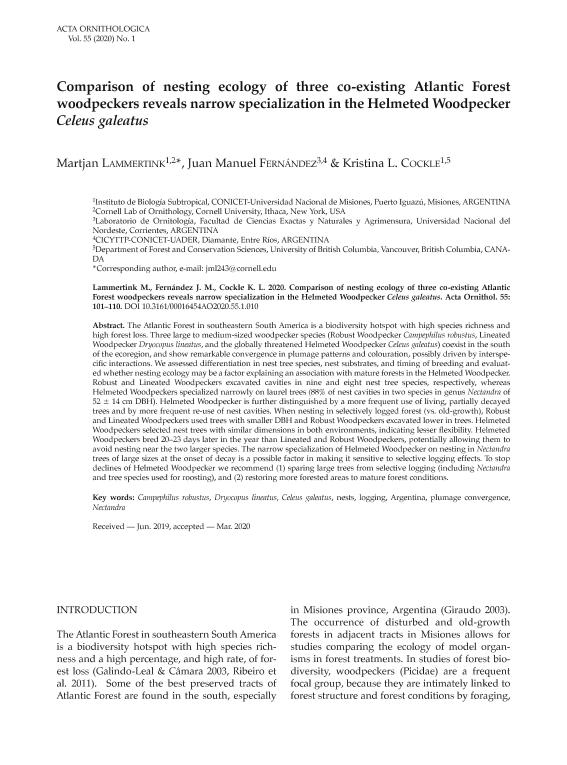Artículo
Comparison of nesting ecology of three co-existing Atlantic Forest woodpeckers reveals narrow specialization in the Helmeted Woodpecker Celeus galeatus
Fecha de publicación:
06/2020
Editorial:
Polish Academy of Sciences. Museum and Institute of Zoology
Revista:
Acta Ornithologica
ISSN:
0001-6454
Idioma:
Inglés
Tipo de recurso:
Artículo publicado
Clasificación temática:
Resumen
The Atlantic Forest in southeastern South America is a biodiversity hotspot with high species richness and high forest loss. Three large to medium-sized woodpecker species (Robust Woodpecker Campephilus robustus, Lineated Woodpecker Dryocopus lineatus, and the globally threatened Helmeted Woodpecker Celeus galeatus) coexist in the south of the ecoregion, and show remarkable convergence in plumage patterns and colouration, possibly driven by interspecific interactions. We assessed differentiation in nest tree species, nest substrates, and timing of breeding and evaluated whether nesting ecology may be a factor explaining an association with mature forests in the Helmeted Woodpecker. Robust and Lineated Woodpeckers excavated cavities in nine and eight nest tree species, respectively, whereas Helmeted Woodpeckers specialized narrowly on laurel trees (88% of nest cavities in two species in genus Nectandra of 52 ± 14 cm DBH). Helmeted Woodpecker is further distinguished by a more frequent use of living, partially decayed trees and by more frequent re-use of nest cavities. When nesting in selectively logged forest (vs. old-growth), Robust and Lineated Woodpeckers used trees with smaller DBH and Robust Woodpeckers excavated lower in trees. Helmeted Woodpeckers selected nest trees with similar dimensions in both environments, indicating lesser flexibility. Helmeted Woodpeckers bred 20-23 days later in the year than Lineated and Robust Woodpeckers, potentially allowing them to avoid nesting near the two larger species. The narrow specialization of Helmeted Woodpecker on nesting in Nectandra trees of large sizes at the onset of decay is a possible factor in making it sensitive to selective logging effects. To stop declines of Helmeted Woodpecker we recommend (1) sparing large trees from selective logging (including Nectandra and tree species used for roosting), and (2) restoring more forested areas to mature forest conditions.
Archivos asociados
Licencia
Identificadores
Colecciones
Articulos(CCT - NORDESTE)
Articulos de CTRO.CIENTIFICO TECNOL.CONICET - NORDESTE
Articulos de CTRO.CIENTIFICO TECNOL.CONICET - NORDESTE
Articulos(IBS)
Articulos de INSTITUTO DE BIOLOGIA SUBTROPICAL
Articulos de INSTITUTO DE BIOLOGIA SUBTROPICAL
Citación
Lammertink, J. Martjan; Fernández, Juan Manuel; Cockle, Kristina Louise; Comparison of nesting ecology of three co-existing Atlantic Forest woodpeckers reveals narrow specialization in the Helmeted Woodpecker Celeus galeatus; Polish Academy of Sciences. Museum and Institute of Zoology; Acta Ornithologica; 55; 1; 6-2020; 101-110
Compartir
Altmétricas




